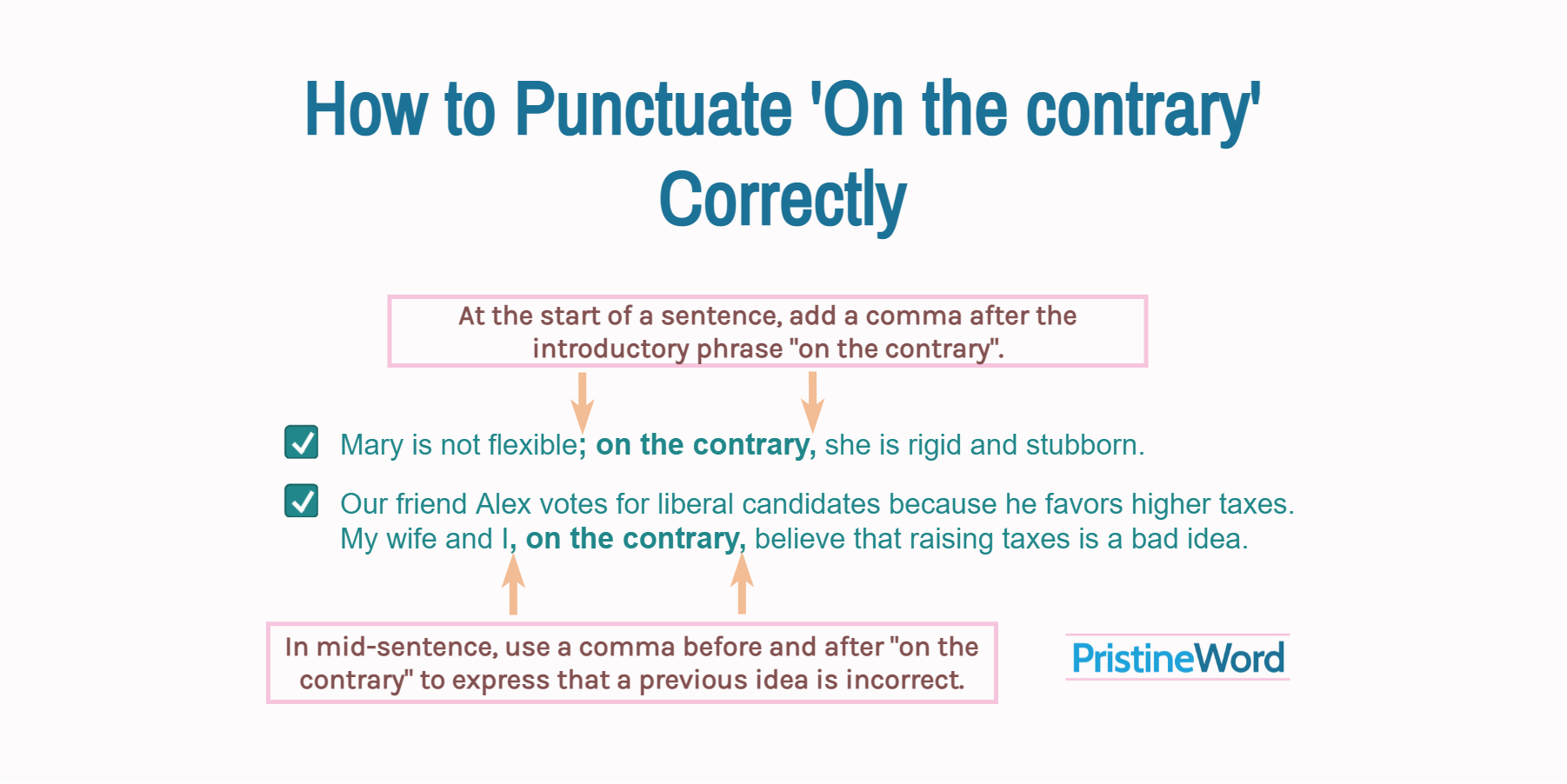At the start of a sentence, add a comma after the phrase "on the contrary" or to the contrary. In mid-sentence, use a comma before and after "on the contrary" to state that a previous idea is incorrect.
At the start of a sentence, add a comma after the phrase "on the contrary" or "to the contrary".
Mary is not flexible; on the contrary, she is rigid and stubborn.
Mary is not flexible; on the contrary she is rigid and stubborn.
In mid-sentence, use a comma before and after "on the contrary" to state that a previous assertion is incorrect.
Our friend Alex votes for liberal candidates because he favors higher taxes. We, on the contrary, believe that raising taxes is a bad idea.
Contents
1. Proper Use of 'On the contrary'
We use "on the contrary" (or "to the contrary") to deny a previous statement or express that, actually, the opposite is true.
I love Thai soups; my son, to the contrary, hates them because he can't handle spicy food.
"On the contrary" is considered a fairly strong objection to another person's statement or claim.
James says that my coworker is organized and trustworthy; on the contrary, she is unreliable and disorganized.
Note that we use "on the contrary" to introduce an opposite opinion or assertion. If you simply need to add a different perspective, which does not contradict the previous statement, use other expressions such as "however", "on the other hand", or "by contrast" instead.
I love Asian food; my wife, however, prefers American food.
I love Asian food; my wife, on the contrary, prefers American food.
2. How to Use Punctuation Marks Before and After 'On the contrary'
At the beginning of a sentence, "on the contrary" typically functions as an opening to a longer explanation.
He said that the project doesn't meet our expectations. On the contrary, I think that it will be successful because it is well planned as well as supported by a strong team.
When using it as an introductory phrase, "on the contrary" should be preceded by a period or a semicolon and followed by a comma.
Everybody thought that Michael was wealthy. On the contrary, he is deep in debt.
I was expecting lower inflation rates. On the contrary, soaring energy prices and supply disruptions drove consumer prices higher.
Instead of a period, you can use a semicolon to narrow the gap between two closely linked sentences.
My new girlfriend is not tall; on the contrary, she is short.
Notice that we do not capitalize ordinary words after a semicolon.
The boss thinks that Rebecca is reliable and responsible; on the contrary, she lacks of engagement.
Use a comma before and after "on the contrary" in the middle of a sentence.
I thought that Barbara was happy but, on the contrary, she was depressed and sad.
In mid-sentence, "on the contrary" is usually an interrupter.
In my opinion, the dress is horrible. Margaret, on the contrary, thinks that the outfit is nice.
Do not forget the closing comma, also known as the appositive comma, after "on the contrary".
Russia is the largest country in the world. The Vatican City, on the contrary, is the smallest country worldwide.
Russia is the largest country in the world. The Vatican City, on the contrary is the smallest country worldwide.
Recommended: Using commas with conjunctive adverbs
3. Conclusion
Typically, "on the contrary" is either an introductory phrase or an interrupter. Follow this simple strategy to punctuate "on the contrary" (or "to the contrary") in a sentence.
- As an introductory phrase, "on the contrary" should be preceded by a period or a semicolon, and it should be followed by a comma.
- "On the contrary" should be surrounded between commas in mid-sentence to signal a pause before denying or contradicting a previous statement.

